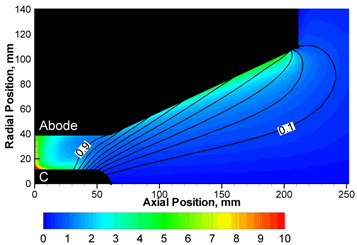Numerical Plasma Simulation on Advanced Space Propulsion Systems
JAXA Supercomputer System Annual Report April 2016-March 2017
Report Number: R16E0115
- Responsible Representative: Eiichi Sato(Department of Space Flight Systems, Institute of Space and Astronautical Science, Japan Aerospace Exploration Agency)
- Contact Information: Ikkoh Funaki(funaki.ikkoh@jaxa.jp)
- Members: Akira Kawasaki, Shitan Tauchi, Satoshi Tonooka, Yusuke Furukawa, Hiroyuki Arai
- Subject Category: Space(Space engineering)
Abstract
A numerical design tool for spacecraft electric and advanced propulsion systems is ivevitably important for quick and robust design without depending only on experimental method. In this fiscal year, Magnetoplasmadynamic (MPD) arcjet, one of high-power spacecraft electric propulsion, was studied to make a test simulation with a discharge plasma model included. MAPS code we developed enabled a combined analysis of the Navier-Stokes equation and the Maxwell equation, and with this code not only thrust, dischage voltage, and its efficiency, but also heat flux toward the electrodes can be estimated in a self-consistent manner.
Goal
Due to the limitation of the existing spacecraft technology level, it is very difficult to enable solar system explorations in a quick and cost-effective mannger. Objective of this study is to obtain a breakthrough spacecraft propulsion technology that enables solar system exploration of the next generations.
Objective
In this study, numerical design method of electric and advanced spacecraft propulsion is established. In this fiscal year, numerical modeling of Magnetoplasmadynamic (MPD) arcjet is conducted.
References and Links
N/A
Use of the Supercomputer
Since ground testing of high-power spacecraft propulsion system is very costly, designing and testing based on supercomputer simulation is very attractive from the viewpoints of cost and delivery time.
Necessity of the Supercomputer
Design optimization of spacecraft propulsion requires a huge computer resource, hence supercomputer usage is very important.
Achievements of the Year
In the numerical simulation of an MPD arcjet, initial thruster geometry is guessed before starting to find an optimized geometry. Only such initial estimation process is tested in this fiscal year, but overall tool will include thruster geometry estimation part, operation parameter estimation part, as well as numerical codes for plasma flow analysis and thermal analysis. A result of numerical simulation of the plasma flow inside an MPD is shown in Fig.1, where the MAPS code employed for this simulation incorporates both the Navier-Stokes and Maxwell equations in a self-consistent mannger.

Fig.1:Discharge current path and Hall parameter distribution in a self-field MPD thruster (Ar, 1.8g/s, 6kA)
Publications
N/A
Computational Information
- Parallelization Methods: Thread Parallelization
- Process Parallelization Methods: n/a
- Thread Parallelization Methods: Automatic Parallelization
- Number of Processes: 1
- Number of Threads per Process: 6
- Number of Nodes Used: 1
- Elapsed Time per Case (Hours): 10
- Number of Cases: 1273
Resources Used
Total Amount of Virtual Cost(Yen): 1,927,636
Breakdown List by Resources
| System Name | Amount of Core Time(core x hours) | Virtual Cost(Yen) |
|---|---|---|
| SORA-MA | 525,019.55 | 863,525 |
| SORA-PP | 113,263.36 | 967,042 |
| SORA-LM | 0.00 | 0 |
| SORA-TPP | 0.00 | 0 |
| File System Name | Storage assigned(GiB) | Virtual Cost(Yen) |
|---|---|---|
| /home | 47.68 | 449 |
| /data | 476.84 | 4,498 |
| /ltmp | 9,765.63 | 92,119 |
| Archiving System Name | Storage used(TiB) | Virtual Cost(Yen) |
|---|---|---|
| J-SPACE | 0.00 | 0 |
Note: Virtual Cost=amount of cost, using the unit price list of JAXA Facility Utilization program(2016)
JAXA Supercomputer System Annual Report April 2016-March 2017


